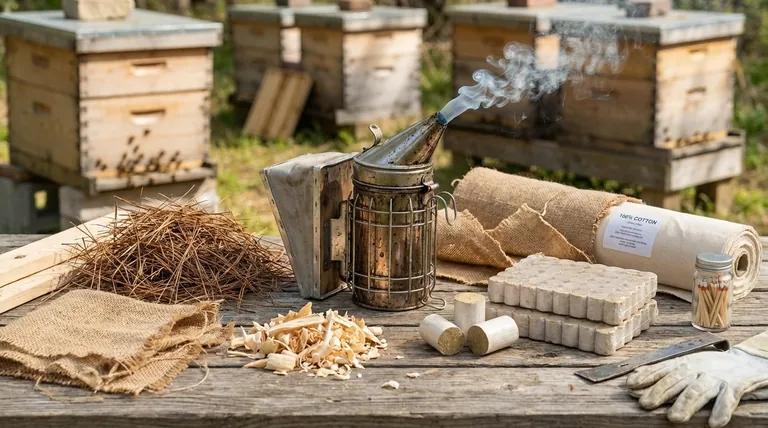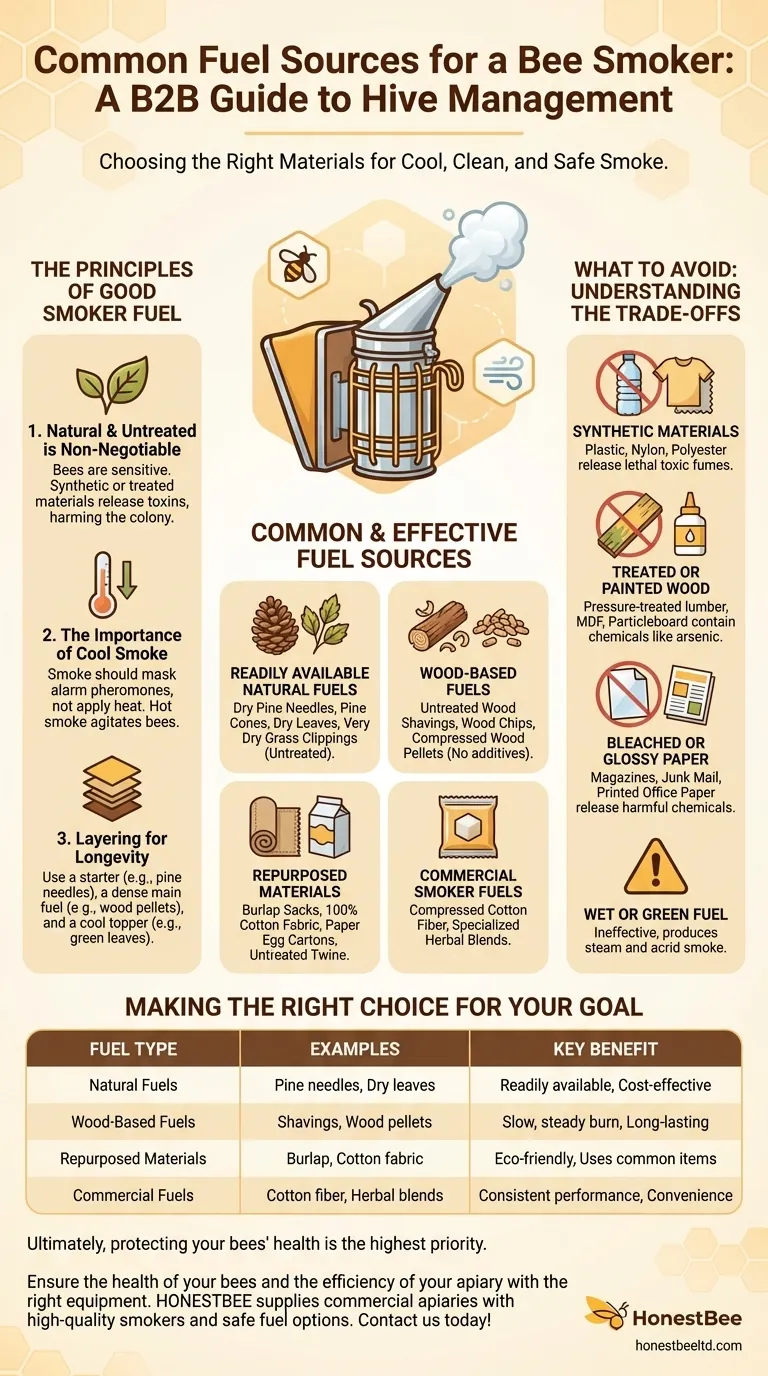To fuel a bee smoker, the most common and effective materials are natural, untreated, and slow-burning. Beekeepers frequently use items like dry pine needles, untreated wood shavings or pellets, burlap from natural fiber sacks, and 100% cotton fabric. The goal is to create a cool, dense smoke that smolders for a long time without producing an open flame or releasing harmful chemicals.
The single most important principle when choosing a smoker fuel is the safety of your bees. The ideal fuel is always a natural, untreated material that burns slowly to produce a large volume of cool, clean smoke, as the smoke is meant to calm the hive, not harm it.

The Principles of Good Smoker Fuel
Understanding why certain fuels work better than others is key to managing your hives effectively and safely. The quality of your smoke directly impacts your bees' response.
Why Natural and Untreated is Non-Negotiable
Your bees are highly sensitive to chemicals. Burning synthetic materials, treated wood, or paper with chemical coatings releases toxic fumes into the hive.
These toxins can agitate, harm, or even kill your bees, defeating the purpose of the smoker and damaging the colony's health.
The Importance of Cool Smoke
The purpose of smoke is not to apply heat, but to mask alarm pheromones, which calms the bees and reduces defensive behavior.
Hot smoke or open flames will be perceived as a direct threat, making the bees more aggressive. A good fuel smolders slowly rather than burning quickly.
Layering Fuel for Longevity and Quality
The most effective way to use a smoker is to layer different types of fuel.
First, you need a starter that lights easily, such as crumpled, untreated cardboard or a handful of dry pine needles.
On top of that, you add your main fuel, a denser material like wood pellets or rolled burlap that will smolder and produce smoke for a long time. You can even add a small handful of green leaves on the very top to further cool the smoke before closing the lid.
Common & Effective Fuel Sources
You can find excellent smoker fuel from many sources, often for free. The key is to verify that they are clean and natural.
Readily Available Natural Fuels
These are often the most convenient and cost-effective options found around your property.
Examples include dry pine needles, pine cones, dry leaves, and very dry grass clippings. Ensure they have not been treated with any pesticides or herbicides.
Wood-Based Fuels
Wood products are a popular choice for their slow, steady burn.
Use untreated wood shavings (pine is excellent), wood chips, or compressed wood pellets designed for barbecues or animal bedding. Always check the packaging to ensure they contain no chemical additives or accelerants.
Repurposed Materials
Many household or farm items make great fuel, provided they are made from 100% natural fibers.
Look for burlap from old coffee or grain sacks, paper egg cartons (not styrofoam), untreated twine, or scraps from an old 100% cotton t-shirt.
Commercial Smoker Fuels
For convenience, you can purchase fuels made specifically for beekeeping. These often come in the form of compressed cotton fiber or specialized herbal blends that are easy to light and produce a pleasant-smelling, long-lasting smoke.
Understanding the Trade-offs: What to Avoid
Knowing what not to burn is just as important as knowing what to burn. Using the wrong fuel can have disastrous consequences for your hive.
Synthetic Materials
Never burn anything containing plastic, nylon, or polyester. These materials release highly toxic fumes that are lethal to bees.
Treated or Painted Wood
Avoid pressure-treated lumber, MDF, particleboard, or any wood that has been painted, stained, or glued. These contain arsenic, formaldehyde, and other chemicals that will contaminate your hive.
Bleached or Glossy Paper
Do not use magazines, junk mail, or printed office paper. The inks, clays, and bleaching agents used in their production can release harmful chemicals when burned.
Wet or Green Fuel
While a small amount of green material on top can cool the smoke, using wet or green fuel as your primary source is ineffective. It will be difficult to keep lit and will produce steam and acrid smoke instead of the cool, dense smoke you need.
Making the Right Choice for Your Goal
Your choice of fuel can be adapted to your situation. The best option combines safety, availability, and performance.
- If your primary focus is convenience: Use commercial smoker pellets or pre-packaged cotton fuel, which are designed for an easy and consistent burn.
- If your primary focus is cost-effectiveness: Use readily available natural materials like dry pine needles, wood shavings from a local woodworker, or untreated burlap sacks.
- If your primary focus is a long-lasting burn: Layer your smoker with an easy-lighting starter like paperboard, followed by a dense main fuel like wood pellets or tightly rolled cotton.
Ultimately, protecting your bees' health is the highest priority when managing a smoker.
Summary Table:
| Fuel Type | Examples | Key Benefit |
|---|---|---|
| Natural Fuels | Dry pine needles, pine cones, dry leaves | Readily available, cost-effective |
| Wood-Based Fuels | Untreated wood shavings, wood pellets | Slow, steady burn, long-lasting |
| Repurposed Materials | Burlap, 100% cotton fabric, paper egg cartons | Eco-friendly, uses common items |
| Commercial Fuels | Compressed cotton fiber, herbal blends | Consistent performance, convenience |
Ensure the health of your bees and the efficiency of your apiary with the right equipment. HONESTBEE supplies commercial apiaries and beekeeping equipment distributors with high-quality, reliable beekeeping supplies, including durable smokers and safe fuel options. Let us help you manage your hives more effectively. Contact our wholesale experts today to discuss your needs and get our latest catalog!
Visual Guide

Related Products
- 54-Piece Smoker Fuel Pellets for Beekeeping Beehive Smoker Fuel
- Premium Traditional Copper Bee Smoker with Bellows
- Economy Galvanized Beekeeping Honey Bee Smoker for Wholesale
- Professional Bee Smoker with Elongated Spout and Durable Bellows for Beekeeping
- Stainless Steel Honey Bee Smoker Hive and Honeycomb Smoker for Beekeeping
People Also Ask
- What is used in a bee smoker? Master the Best Fuels for Calm, Healthy Hives
- What to put in a bee hive smoker? A Guide to Natural, Calming Fuels
- What is the best material for a bee smoker? Choose the Right Fuel for a Calm Hive
- What are important considerations when choosing smoker fuel? A Guide to Safe, Effective Beekeeping
- What fuels are recommended for beehive smokers? Master the Art of Calm, Controlled Inspections



















